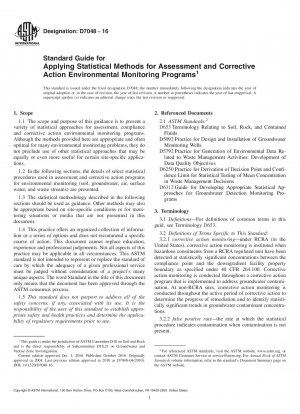ASTM D7048-16
Standard Guide for Applying Statistical Methods for Assessment and Corrective Action Environmental Monitoring Programs
- Standard No.
- ASTM D7048-16
- Release Date
- 2016
- Published By
- American Society for Testing and Materials (ASTM)
- Latest
- ASTM D7048-16
- Scope
5.1 The principal use of this standard is in assessment, compliance and corrective action environmental monitoring programs (for example, for a facility that could potentially contaminate groundwater). The significance of the guidance is that it presents a statistical method that allows comparison of groundwater data to regulatory and/or health based limits.
5.2 Of course, there is considerable support for statistical methods applied to detection, assessment and corrective action monitoring programs that can be applied to environmental sites.
Note 1: For example, in the United States, the 908201;% upper confidence limit (UCL) of the mean is used in USEPA’s SW846 (Chapter 9) for determining if a waste is hazardous. If the UCL is less than the criterion for a particular hazardous waste code, then the waste is not a hazardous waste even if certain individual measurements exceed the criterion. Similarly, in the USEPA Statistical Analysis of Groundwater Monitoring Data at RCRA Facilities Addendum to the Interim Final Guidance (1992) (2), confidence intervals for the mean and various upper percentiles of the distribution are advocated for assessment and corrective action. Interestingly, both the 1989 and 1992 USEPA guidance documents (2, 3) suggest use of the lower 958201;% confidence limit (LCL) as a tool for determining whether a criterion has been exceeded in assessment monitoring.
The latest guidance in this area calls for use of the LCL in assessment monitoring and the UCL in corrective action. In this way, corrective action is only triggered if there is a high degree of confidence that the true concentration has exceeded the criterion or standard, whereas corrective action continues until there is a high degree of confidence that the true concentration is below the criterion or standard. This is the general approach adopted in this guide, as well.5.3 There are several reasons why statistical methods are needed in assessment and corrective action monitoring programs. First, a single measurement indicates very little about the true concentration in the sampling location of interest, and with only one sample it cannot be determined if the measured concentration is a typical or an extreme value. The objective is to compare the true concentration (or some interval that contains it) to the relevant criterion or standard. Second, in many cases the constituents of interest are naturally occurring (for example, metals) and the naturally existing concentrations may exceed the relevant criteria. In this case, the relevant comparison is to background (for example, off-site soil or upgradient groundwater) and not to a fixed criterion. As such, background data should be statistically characterized to obtain a statistical estimate of an upper bound for the naturally occurring concentrations so that it can be confidently determined if onsite concentrations are above background levels. Third, there is often a need to compare numerous potential constituents of concern to criteria or background, at numerous sampling locations. By chance alone there will be exceedances as the number of comparisons becomes large. The statistical approach to this problem can decrease the potential for ......
ASTM D7048-16 Referenced Document
- ASTM D5092 Standard Practice for Design and Installation of Ground Water Monitoring Wells in Aquifers
- ASTM D5792 Standard Practice for Generation of Environmental Data Related to Waste Management Activities: Development of Data Quality Objectives
- ASTM D6250 Standard Practice for Derivation of Decision Point and Confidence Limit for Statistical Testing of Mean Concentration in Waste Management Decisions
- ASTM D6312 Standard Guide for Developing Appropriate Statistical Approaches for Groundwater Detection Monitoring Programs
- ASTM D653 Standard Terminology Relating to Soil, Rock, and Contained Fluids
ASTM D7048-16 history
- 2016 ASTM D7048-16 Standard Guide for Applying Statistical Methods for Assessment and Corrective Action Environmental Monitoring Programs
- 2004 ASTM D7048-04(2010) Standard Guide for Applying Statistical Methods for Assessment and Corrective Action Environmental Monitoring Programs
- 2004 ASTM D7048-04 Standard Guide for Applying Statistical Methods for Assessment and Corrective Action Environmental Monitoring Programs

Copyright ©2024 All Rights Reserved